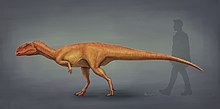Berberosaurus
Appearance
| Berberosaurus | |
|---|---|

| |
| Life restoration and size comparison | |
| Scientific classification | |
| Domain: | Eukaryota |
| Kingdom: | Animalia |
| Phylum: | Chordata |
| Clade: | Dinosauria |
| Clade: | Saurischia |
| Clade: | Theropoda |
| Clade: | Averostra
|
| Clade: | †Ceratosauria |
| Genus: | †Berberosaurus |
| Species: | †B. liassicus
|
| Binomial name | |
| †Berberosaurus liassicus Allain et al., 2007
| |
| Synonyms | |
| |
Berberosaurus (meaning "
epoch. Berberosaurus might be the oldest known ceratosaur, and is based on partial postcranial remains. This genus represents the oldest formally identified theropod from the North of Africa, as well one of the few from the region in the Early Jurassic.[2]
Discovery and history
The remains of Berberosaurus were discovered during a series of expeditions to the High Atlas beginning in the early 2000s, when in 6 years, where made to dig in the local redbeds. It is
theropod within bone beds in mudflow deposits. Later tectonic activity has affected the bones.[2] Recent papers have quoted that new material of this genus was recovered on the same area, namely the axis, a postorbital, the cranium and teeth, that are currently being studied.[3] Berberosaurus is characterized by the following features: the cervical vertebra is highly pneumatic, with short cervical centra and holes in the neural arch, with low and short neural spine, unlike Elaphrosaurus and Ceratosaurus. It has anteroposteriorly short centra and neural spine; the sacral series markedly arched; the central sacrum narrow transversely; the metacarpal with a very grooved proximal end; anterior femoral trochanter reaches proximally to the midpoint of the femoral head, unlike Ceratosaurus; large femoral trochanteric platform; tibia with subtriangular distal profile; presence of an oblique ridge that covers proximally the medial sulcus of the fibula.[2]
Classification
Dal Sasso
and colleagues in 2018Ronan Allain and colleagues, who described Berberosaurus, performed a
Averostra, a classification which was already gaining popularity at around that time.[9]
The classification of Berberosaurus based on Delcourt et al. (2018):
| Ceratosauroidea |
| |||||||||||||||||||||||||||||||||
Paleoecology and paleobiology
Tazouda CS are a unique section due to its evidenced volcanic influence. Similar environments are found in modern Pisgah cinder cone of Mojave Desert. Local floodplains alternated humid and dry periods, where in the last hypersaline Chotts and gypsium dunes likely developed
Berberosaurus, like other ceratosaurians, was a
sauropod Tazoudasaurus. It has been estimated to be approximately 5 m (16 ft) long and 220–300 kg (490–660 lb) in body mass.[13][14]
The "Toundoute Continental Series", unlike other members of the
Coelophysidae with juvenile & adult specimens and a small sauropod have been recovered from Acforcid, E of Demnate, as well Gravisaurian (Tazoudasaurus?[17]) remains at the E of Azilal village, Medium-Sized Sauropod remains at Mizaguène Hill (SW Azilal) and indeterminate Dinosaur remains from other locations around Azilal and Demnate.[18]
See also
References
- .
- ^ S2CID 131617581.
- ^ Ibrahim, N.; Sereno, P. C.; Zouhri, S.; Zouhri, S. (2017). "Les dinosaures du Maroc–aperçu historique et travaux récents" (PDF). Mémoires de la Société Géologique de France. 180 (4): 249–284. Retrieved 21 April 2023.
- ^ Carrano & Sampson, 2008. The phylogeny of Ceratosauria (Dinosauria: Theropoda). Journal of Systematic Palaeontology. 6, 183-236.
- S2CID 4358448.
- .
- S2CID 56894865.
- PMID 29950661.
- S2CID 212669998.
- ISBN 0-520-24209-2.
- ISBN 0-671-61946-2.
- ^ Paul, Gregory S. (1988). Predatory Dinosaurs of the World. 268.
- OCLC 985402380.
- ^ Molina-Pérez & Larramendi (2016). Récords y curiosidades de los dinosaurios Terópodos y otros dinosauromorfos. Barcelona, Spain: Larousse. p. 255.
- ^ S2CID 129577717. Retrieved January 25, 2022.
- . Retrieved 25 January 2022.
- ISBN 978-2081353053. Retrieved 25 January 2022.
- ^ Jenny, J.; Jenny-Deshusses, C.; Le Marrec, A.; Taquet, P. (1980). "Découverte d'ossements de Dinosauriens dans le Jurassique inférieur (Toarcien) du Haut Atlas central (Maroc) [Discovery of dinosaur bones in the Lower Jurassic (Toarcian) of the central High Atlas (Morocco)]". Comptes Rendus de l'Académie des Sciences, Série D. 290 (1): 839–842. Retrieved 25 January 2022.


